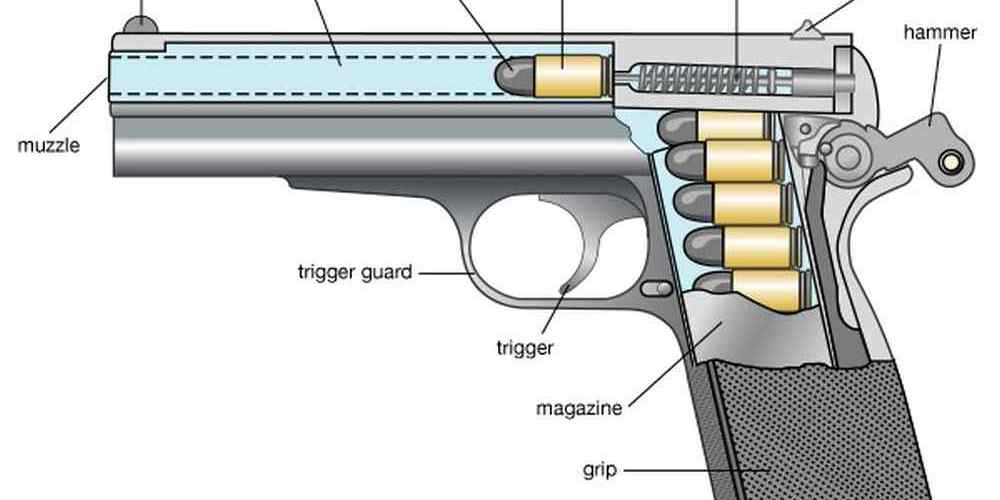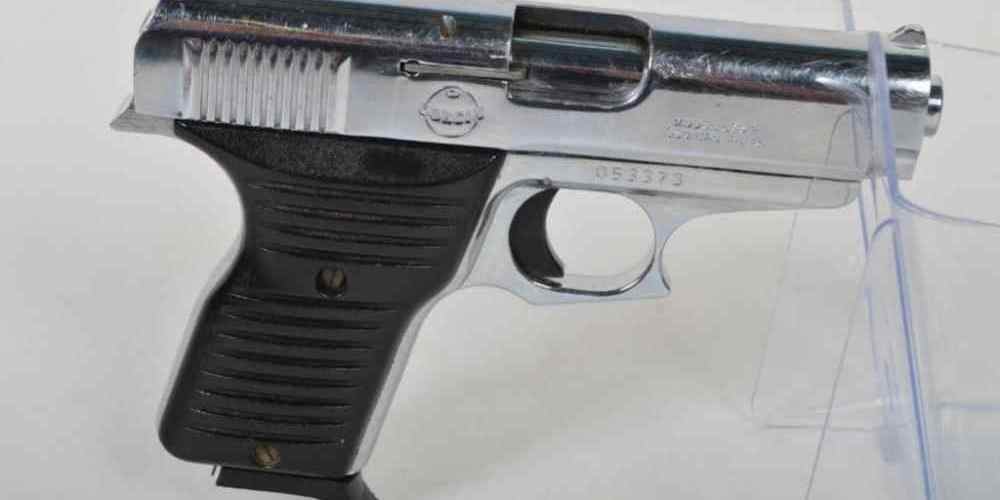Unlock the power of semi-auto pistols with a deeper understanding of their mechanics.
How Semi-Auto Pistols Work
Semi-automatic pistols are a popular choice for many gun owners due to their ease of use and reliability. Understanding how these firearms work can help you become a more knowledgeable and responsible gun owner.
At the heart of a semi-automatic pistol is the firing mechanism, which allows the gun to fire a round each time the trigger is pulled. Unlike a revolver, which requires manual cocking of the hammer for each shot, a semi-automatic pistol uses the energy from the fired round to automatically cycle the action and load the next round into the chamber.
When the trigger is pulled, it releases the firing pin or striker, which strikes the primer of the cartridge, igniting the gunpowder and firing the bullet. The force of the fired round pushes the slide rearward, ejecting the spent casing and compressing the recoil spring.
As the slide moves rearward, it also cocks the hammer or striker for the next shot. The recoil spring then pushes the slide forward, stripping a new round from the magazine and chambering it. The gun is now ready to fire again with a simple pull of the trigger.
One of the key components of a semi-automatic pistol is the magazine, which holds the ammunition and feeds it into the chamber. Most semi-automatic pistols use detachable box magazines, which can be quickly and easily loaded and inserted into the gun.
The magazine is inserted into the grip of the pistol, where a spring-loaded follower pushes the rounds upward towards the chamber. As the slide cycles, it strips a round from the top of the magazine and feeds it into the chamber, ready to be fired.
Another important component of a semi-automatic pistol is the slide, which houses the firing mechanism and reciprocates during the firing cycle. The slide is typically made of steel or aluminum and moves back and forth on rails machined into the frame of the gun.
The frame of a semi-automatic pistol is the central component that holds all the other parts together. It provides a solid foundation for the firing mechanism, slide, and barrel, as well as a comfortable grip for the shooter.

The barrel of a semi-automatic pistol is where the bullet travels as it is fired from the gun. The barrel is typically rifled, with grooves cut into the bore to impart spin on the bullet for improved accuracy.
Overall, understanding the mechanics of a semi-automatic pistol can help you appreciate the engineering and craftsmanship that goes into these firearms. By knowing how your gun works, you can better maintain and care for it, ensuring years of reliable performance at the range or in self-defense situations.
Different Types of Semi-Auto Pistols
Semi-automatic pistols are a popular choice for many gun owners due to their ease of use and reliability. Understanding the mechanics of semi-auto pistols can help you make an informed decision when choosing a firearm. There are several different types of semi-auto pistols, each with its own unique features and benefits.
One of the most common types of semi-auto pistols is the striker-fired pistol. This type of pistol uses a striker mechanism to ignite the primer and fire the round. Striker-fired pistols are known for their consistent trigger pull and minimal external controls, making them easy to operate for shooters of all skill levels. Popular examples of striker-fired pistols include the Glock and Smith & Wesson M&P series.
Another type of semi-auto pistol is the hammer-fired pistol. These pistols use a hammer mechanism to strike the firing pin and ignite the primer. Hammer-fired pistols typically have a more traditional trigger pull compared to striker-fired pistols, which some shooters prefer. Examples of hammer-fired pistols include the Beretta 92 and Sig Sauer P226.
Some semi-auto pistols feature a double-action/single-action (DA/SA) trigger system. In a DA/SA pistol, the first shot is fired in double-action mode, where pulling the trigger both cocks and releases the hammer. Subsequent shots are fired in single-action mode, where the hammer is cocked by the slide cycling and the trigger only releases it. This system provides shooters with the option of a longer, heavier trigger pull for the first shot, followed by lighter, shorter trigger pulls for subsequent shots. Popular DA/SA pistols include the CZ 75 and HK USP.
There are also semi-auto pistols that feature a single-action-only (SAO) trigger system. In an SAO pistol, the hammer is cocked manually or by the slide cycling, and pulling the trigger releases it. SAO pistols typically have a light, crisp trigger pull, making them popular among competition shooters and enthusiasts. Examples of SAO pistols include the 1911 and Browning Hi-Power.
Some semi-auto pistols feature a double-action-only (DAO) trigger system. In a DAO pistol, the trigger performs both the cocking and releasing of the hammer for each shot. DAO pistols typically have a longer, heavier trigger pull compared to other trigger systems, which can be a safety feature for some shooters. Examples of DAO pistols include the Smith & Wesson Bodyguard and Kahr CW9.
Understanding the different types of semi-auto pistols and their trigger systems can help you choose the right firearm for your needs and preferences. Whether you prefer a striker-fired pistol for its simplicity, a hammer-fired pistol for its traditional feel, or a DA/SA, SAO, or DAO pistol for their specific trigger systems, there is a semi-auto pistol out there for you. Take the time to research and test different types of pistols to find the one that feels comfortable and reliable for you.
Pros and Cons of Semi-Auto Pistols
Semi-automatic pistols are a popular choice for many gun owners due to their ease of use and versatility. Understanding the mechanics of how these firearms work can help you make an informed decision about whether or not they are the right choice for you.
One of the key features of a semi-automatic pistol is its ability to automatically chamber a new round after each shot is fired. This is achieved through the use of a recoil-operated mechanism, which uses the force generated by the fired round to cycle the action and load a new cartridge into the chamber. This allows for rapid and efficient firing without the need to manually chamber each round.
Another advantage of semi-automatic pistols is their high capacity magazines, which allow for multiple rounds to be fired before needing to reload. This can be especially useful in self-defense situations where quick follow-up shots may be necessary. Additionally, semi-automatic pistols are typically easier to shoot accurately than revolvers, due to their lighter trigger pull and reduced recoil.
However, there are also some drawbacks to consider when it comes to semi-automatic pistols. One of the main concerns is their potential for jamming, especially if they are not properly maintained or if low-quality ammunition is used. This can be a serious issue in a self-defense situation where reliability is crucial.
Another downside to semi-automatic pistols is their complexity compared to revolvers. While revolvers are relatively simple to operate and maintain, semi-automatic pistols require more training and practice to use effectively. This includes learning how to properly load and unload the firearm, as well as how to clear malfunctions if they occur.
Despite these drawbacks, semi-automatic pistols remain a popular choice for many gun owners due to their versatility and ease of use. With proper training and maintenance, they can be reliable and effective tools for self-defense or recreational shooting.
In conclusion, understanding the mechanics of semi-automatic pistols can help you make an informed decision about whether or not they are the right choice for you. While they offer many advantages, such as high capacity magazines and ease of use, they also come with some drawbacks, such as potential for jamming and complexity. Ultimately, the decision to purchase a semi-automatic pistol should be based on your individual needs and preferences, as well as your willingness to invest the time and effort required to become proficient with this type of firearm.
Maintenance and Cleaning Tips for Semi-Auto Pistols
Semi-automatic pistols are popular firearms due to their ease of use and reliability. However, like any mechanical device, they require regular maintenance and cleaning to ensure they function properly. Understanding the mechanics of semi-auto pistols can help gun owners properly care for their firearms and prevent malfunctions.
One of the key components of a semi-automatic pistol is the slide. The slide houses the firing pin, extractor, and ejector, and is responsible for cycling the action of the pistol. To properly maintain the slide, it should be regularly cleaned and lubricated to prevent dirt and debris from causing malfunctions. Additionally, the recoil spring and guide rod should be inspected for wear and tear, as they play a crucial role in controlling the slide’s movement.
The barrel is another important component of a semi-automatic pistol. The barrel is where the bullet travels through before being fired, and it must be kept clean to ensure accuracy and reliability. To clean the barrel, a bore brush and solvent should be used to remove fouling and residue. Additionally, the chamber should be inspected for any obstructions that could prevent proper feeding and extraction of rounds.
The trigger mechanism is another critical component of a semi-automatic pistol. The trigger is responsible for releasing the firing pin and firing the gun, so it must be kept clean and free of debris. Regularly inspecting the trigger mechanism for wear and tear can help prevent malfunctions and ensure the pistol fires reliably.
Magazines are also an essential part of a semi-automatic pistol. The magazine feeds rounds into the chamber and must be properly maintained to prevent feeding issues. To clean a magazine, it should be disassembled and inspected for dirt and debris. Additionally, the magazine spring should be checked for proper tension to ensure reliable feeding.
Proper maintenance and cleaning of a semi-automatic pistol can help prevent malfunctions and ensure the firearm functions reliably. Regularly inspecting and cleaning the slide, barrel, trigger mechanism, and magazines can help gun owners identify potential issues before they become serious problems. By understanding the mechanics of semi-auto pistols and following proper maintenance and cleaning procedures, gun owners can enjoy their firearms safely and confidently.
In conclusion, semi-automatic pistols are reliable firearms that require regular maintenance and cleaning to ensure they function properly. Understanding the mechanics of semi-auto pistols can help gun owners properly care for their firearms and prevent malfunctions. By regularly inspecting and cleaning the slide, barrel, trigger mechanism, and magazines, gun owners can prevent issues and enjoy their firearms safely. Proper maintenance and cleaning are essential for keeping semi-automatic pistols in top condition and ensuring they perform reliably when needed.
Common Malfunctions and Troubleshooting for Semi-Auto Pistols
Semi-automatic pistols are popular firearms due to their ease of use and reliability. However, like any mechanical device, they can experience malfunctions from time to time. Understanding common malfunctions and how to troubleshoot them is essential for any gun owner.
One of the most common malfunctions with semi-auto pistols is failure to feed. This occurs when a round fails to enter the chamber properly. This can be caused by a variety of factors, such as a dirty or damaged magazine, improper ammunition, or a weak magazine spring. To troubleshoot this issue, first, ensure that the magazine is properly seated in the pistol. If the issue persists, try using a different magazine or cleaning the existing one. Additionally, make sure you are using the correct ammunition for your pistol.
Another common malfunction is failure to eject, also known as a stovepipe. This occurs when a spent casing fails to eject from the pistol properly and becomes stuck in the ejection port. This can be caused by a weak extractor, a dirty chamber, or improper grip on the pistol. To troubleshoot this issue, first, check the extractor for any damage or debris. Clean the chamber thoroughly and ensure you are gripping the pistol properly to allow for proper ejection.
Failure to fire is another common issue with semi-auto pistols. This occurs when the trigger is pulled, but the round does not fire. This can be caused by a variety of factors, such as a faulty firing pin, improper ammunition, or a dirty chamber. To troubleshoot this issue, first, check the firing pin for any damage or debris. Ensure you are using the correct ammunition for your pistol and clean the chamber thoroughly to prevent any obstructions.
Misfeeds are also a common malfunction with semi-auto pistols. This occurs when a round fails to feed properly into the chamber, resulting in a jam. This can be caused by a variety of factors, such as a dirty or damaged magazine, improper ammunition, or a weak magazine spring. To troubleshoot this issue, first, ensure that the magazine is properly seated in the pistol. If the issue persists, try using a different magazine or cleaning the existing one. Additionally, make sure you are using the correct ammunition for your pistol.
In conclusion, understanding the mechanics of semi-auto pistols and common malfunctions is essential for any gun owner. By knowing how to troubleshoot these issues, you can ensure that your pistol remains reliable and safe to use. Remember to always follow proper safety procedures when handling firearms and seek professional help if you are unsure how to address a malfunction. With proper care and maintenance, your semi-auto pistol can provide you with years of reliable service.




